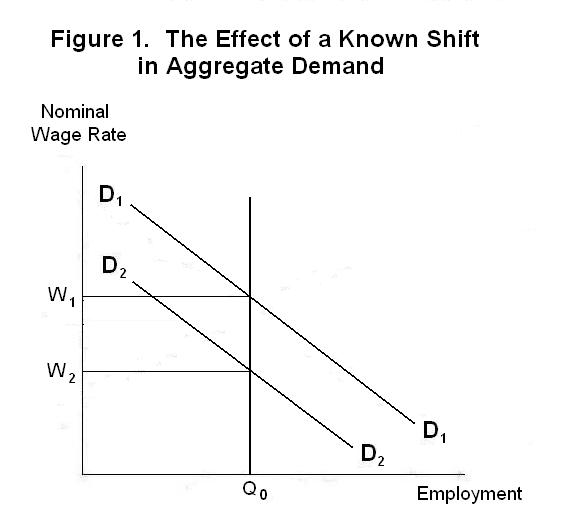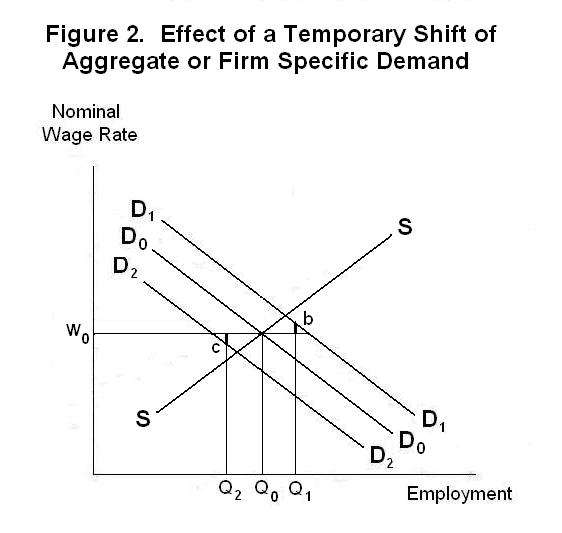
The fundamental feature of contract theories is that firms
and workers make an implicit contract by which the firm will guarantee its
employees, once they have obtained sufficient seniority, continuous
employment at a real wage rate that is invariant to changes in market
conditions. In return, the employees agree to work for wages that
are lower than they would require if stability of employment and
wages were not guaranteed. As a consequence of such contracts,
firms lay off junior workers in recessions and hire them back in
booms. Our first concern is to understand why workers and firms would
make such contracts and how those contracts are enforced.
Most workers have large fractions of their wealth invested
in their human skills---if the market for those skills goes bad
their income will decline drastically. Workers will pay a price
in terms of wages to achieve income stability. The owners of
firms, on the other hand, have ample opportunity to diversify
their wealth-holdings across a wide portfolio of assets. They
can thus acquire somewhat reasonable security of income by sharing
ownership in a number of firms and holding part of their wealth
in bonds and fixed-income assets. Unforeseen losses on some assets
will thus tend to be offset by unforeseen gains on others.
Given that workers cannot diversify their wealth-portfolios
as well as can the owners of firms, it is in their interest to
make deals with their employers. The owners of firms can gain
by absorbing increased variability of profits, which they can
diversify away by holding a wide variety of assets, in return
for maintaining stable levels of employment at steady but suffiently
lower wages to achieve higher long-run average profit levels. And
workers thereby achieve security by accepting lower wages.
The security workers buy in this way will frequently extend
well beyond the mere stabilization of wages across booms and
recessions, encompassing pension plans, paid sick leave, medical
insurance, and so forth. Indeed, even when there are no labour unions
firms typically take pains to ensure that no one is fired without good
reason and that promotions are based on performance, not friendships.
They do this in part to minimize risk for their employees and thereby be
able to hire workers at wages that are lower in compensation for
the greater financial security they provide. It is thus possible
for workers to purchase, in return for accepting lower wages,
insurance against unforeseen events and arbitrary behaviour of their
employers that could not otherwise be purchased in the market.
But how are these contracts enforced? Contractual details
are difficult to write down because many aspects of the relations
between employers and employees depend on common sense and good
judgment and cannot be measured on a quantitative scale. What is
to stop an employer from paying low wages in the understanding
that job security will be provided, and then dumping a worker on
some pretext when conditions change and there is immediate gain
from abrogating the contract? The main reason a firm would not
behave in this way is that word would get around among current
and prospective employees and the firm would no longer be able
to hire good workers at low wages. The contract is an implicit
one, enforced not by courts of law but by the needs of firms to
maintain their reputations. For this reason such contracts are
often called quasi-contracts.
We can now analyze the implications of these contracts for
employment levels over the business cycle. The contracts are
designed to protect workers against a wide variety of unforseen
shocks, not just cyclical changes in demand. They protect against
obsolescence of skills, in which case the employer would pay for
retraining or shift the worker to a job that he/she could handle,
without reduction in salary. But they do not protect workers
against their own incompetence if clearly established. Also, when
the survival of the firm is in jeopardy an alteration in the terms
of the contract will be widely perceived as justified---the reputation
of a failed firm is worthless in any event.
These implicit contracts are, of course, based on real, not
nominal, wages. So if everyone knows that there is a downward
shock to aggregate demand which lowers equilibrium nominal wages
and prices by 10 percent, nominal wages will be immediately adjusted
downward by that amount with the agreement of all concerned. This
can be seen in Figure 1 which portrays the situation for a typical
firm. Due to a shift in aggregate demand in the economy as a whole
the firm's demand for labour shifts from D1D1
to D2D2. Nominal wages fall immediately
from W1 to W2 with employment
unchanged. It follows that nominal wages will be constantly adjusted by the
expected inflation rate in the economy as was the case in our
previous auction and search models.
While the previous theoretical sketches explain many common
features of cyclical unemployment they give us no understanding
of why firms lay workers off in recessions and refuse to hire
people willing to work at or below the wages currently being
paid. We now turn to the development of a contract theory that
will explain this phenomenon. Our theory will contain relevant
features of the several contract theories that have been devised
by economists in the past.

Suppose now that economy-wide changes in aggregate demand occur that are perceived either as temporary economy-wide changes or temporary firm-specific changes. Firms have contractual reasons not to make wage adjustments in response to these shifts. Analysis can proceed with reference to Figure 2. Suppose that demand shifts alternately between D1D1 and D2D2. The firm will hold wage rates constant at some average level W0 reflecting the average level of demand and vary employment between Q1 and Q2. Were the firm to vary wages, workers would vary employment offered along the supply curve SS. This supply curve is drawn with the understanding that all other firms in the industry, and the whole economy, would be making the same wage adjustments in response to the same shocks to their demand curves for labour.

Instead of varying wages, however, the firm adjusts employment by laying off and rehiring workers at a fixed wage rate reflecting its estimate of long-term market conditions. As a result the value marginal product of labour, measured by the distance between the demand curve and the horizontal axis, is below the wage rate in periods of slack demand and above it in periods of excessive demand, as shown by the thick line-segments at points c and b . A crucial part of the argument is that workers are indexed along the horizontal axis by seniority, starting with the most senior worker at the origin with increasingly less senior ones out along the axis to the right. As the firm varies employment between Q1 and Q2 less senior workers are layed off first and rehired last. This is in contrast to the movement along the SS curve where workers would vary their labour supply according to the aggregate of individual preferences.
The firm could increase its current-period profits by hiring less workers than Q2 in bad times and more workers than Q1 in good times. But this would in fact lower its long-run profits because it would then have to pay a wage rate above W0 to compensate its workers for the greater uncertainty of income and employment. In effect, the firm is making life-time contracts with its employees, guaranteeing them reasonable treatment along with increased income stability as seniority is acquired. It is in its interest to do so because the average level of wages it will have to pay will then be less.
The contract theory just developed explains why firms lay off workers in recessions. Even if everyone knows that the level of nominal aggregate demand is below normal, it pays for layoffs to occur instead of wage cuts to provide income stability for the more senior workers. And in periods when aggregate demand is temporarily high, it pays firms to maintain wage stability, rehiring workers that they had layed off in previous slack periods or hiring new workers who will accept the current wage in order to build up seniority. It should now be obvious that the contract theory explains why workers do not quit their jobs in recessions. Moves between jobs occur in boom periods when firms are hiring.
Under the auction and search theories, a crucial feature of unemployment rate fluctuations was missinformation about the state of aggregate demand. Under the contract theory, employment will fluctuate around its natural level even if the state of aggregate demand is always known. Of course, the unemployment rate will also fluctuate under the contract theory in response to unforseen shocks to aggregate demand.
When there is a permanent change in the equilibrium rate of inflation in the economy, the time path of nominal wages will respond immediately when the change is known and there are quasi-contracts between firms and workers because there is no incentive to delay the path of nominal adjustment. But with union contracts that are in writing there may be an incentive on the part of one or both parties to not renegotiate previously agreed-upon multi-year wage rate provisions. When workers and firms do not realize that fundamental changes in the inflation rate are occurring, there is a further reason for nominal wage adjustment to be delayed.
It is test time. Be sure to think up your own answers before looking at the ones provided.
Question 1
Question 2
Question 3
Choose Another Topic in the Lesson